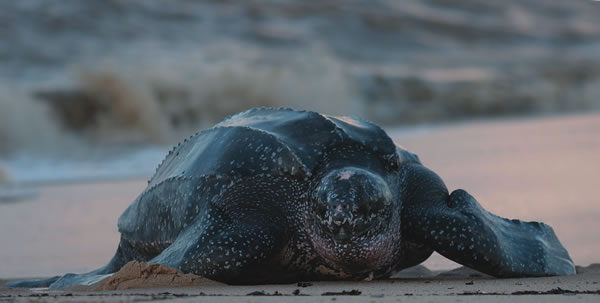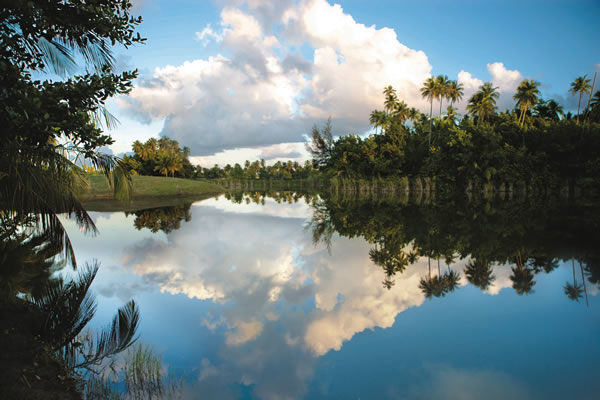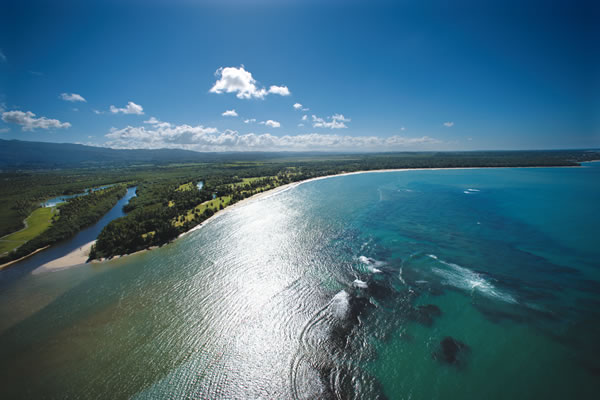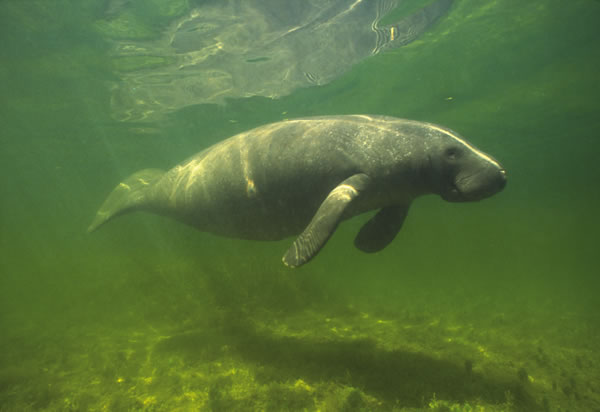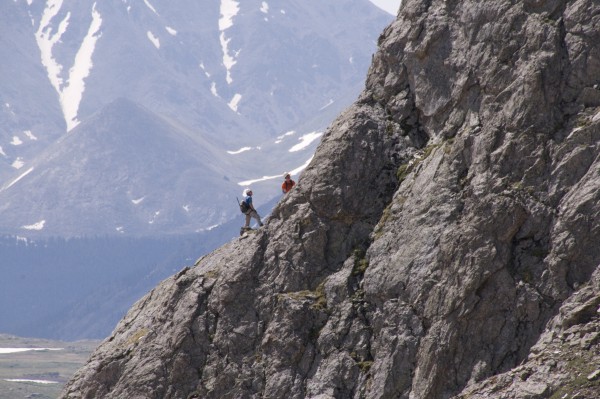Leatherback turtles, manatees and countless other endangered species return to Bahia Beach year after year.- By Lanee Lee
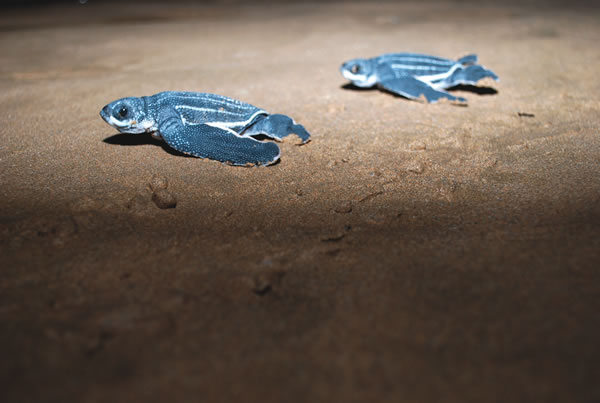 The miracle of life never grows old and on the island of Puerto Rico, visitors have the opportunity to see the wonders of nature in an unparalleled setting. Annually, from February through August, more than 20 female leatherback turtles raise themselves out the ocean to nest on Bahia Beach, located on the northeastern corridor of the island. Described as an emotionally intense experience by naturalist Marcela Cañón of Bahia Beach Resort & Golf Club, the mammoth leatherback sea turtles hatch approximately 80 – 150 eggs on the sands near The St. Regis Bahia Beach Resort each year.
The miracle of life never grows old and on the island of Puerto Rico, visitors have the opportunity to see the wonders of nature in an unparalleled setting. Annually, from February through August, more than 20 female leatherback turtles raise themselves out the ocean to nest on Bahia Beach, located on the northeastern corridor of the island. Described as an emotionally intense experience by naturalist Marcela Cañón of Bahia Beach Resort & Golf Club, the mammoth leatherback sea turtles hatch approximately 80 – 150 eggs on the sands near The St. Regis Bahia Beach Resort each year.
“It is magical to see them come out of the ocean and lay eggs,” Cañón says. “Guests are moved, some crying. Kids scream, so happy with eyes wide open. It’s seeing nature at its best—really a life changing experience.”
An Exceptional Evolution
The appearance of the leatherbacks is a big deal, in the most literal sense. As the world’s largest turtle, leatherbacks reach 4 to 8 feet in length and 500 to 2,000 pounds. The biggest leatherback ever found was in 1988, when an 8.5-foot long male weighing 2,020 pounds washed up on the west coast of Wales, England.
A rare and dying breed, these turtles can trace the species’ evolutionary roots back more than 65 million years. Facing extinction, the prehistoric leatherbacks, among many other turtles, are protected as a critical species under the U.S. Endangered Species Act. According to statistics from the nonprofit Leatherback Trust, in 1980, there were more than 115,000 adult females, but there are now less than 25,000 worldwide. The turtles are nearly extinct in the Pacific Ocean. They have no natural predators, but accidental deaths occur due to fishermen’s boats or nets, nesting grounds disturbed by coastal development or by ingesting large amounts of plastic shopping bags mistaken for jellyfish, their meal of choice.
Tracking a leatherback’s voyage is nearly impossible. Not only do they have the widest global distribution of all reptile species, they have the longest migrations between breeding and feeding areas of any sea turtle, averaging 3,700 miles each way. When females finally come ashore (males never return), the average time it takes her to excavate a hole, give birth and bury the nest with sand is only two hours before she returns to her watery domain.
Those staying at The St. Regis Bahia Beach Resort during nesting season won’t miss the momentous occasion—all guests are asked upon check-in if they would like a wake-up call if and when a nesting or hatching is occurring. Most births take place in the early hours of the morning, but the hotel staff will escort interested parties by golf cart to watch the precious miracle of life ensue.
Preserving Nature
On average, only one in every 1,000 eggs and hatchlings survive due to poachers, animal predators and human influences. With a long incubation phase of over two months, vandalized nests are common occurrences. Animals such as iguanas and dogs feast on the eggs, while poachers steal them for their supposed aphrodisiacal power.
But there is hope for the leatherback nesting on the two miles of Atlantic Ocean beach along the border of the Bahia Beach Resort & Golf Club. In 2008, the former coconut plantation of 483 acres, on which The St. Regis Bahia Beach Resort is also located, was designated as the first and only certified gold Audubon Signature Sanctuary in the Caribbean. As part of the Bahia Beach Resort community outreach, Cañón and her team spend countless hours educating locals about protecting leatherback turtles.
With the help of community outreach efforts and preservation measures enacted by the resort in coordination with officer Francisco Guzman from the Department of Natural and Environmental Resources of Puerto Rico, the survival rates of hatchlings on Bahia Beach reaching adulthood are now more like 10 in 1000, Cañón estimates.
Replanting vegetation, rebuilding sand dunes and removing all harsh lighting has restored the beaches, creating a more hospitable environment for leatherback turtles’ nighttime nesting. Once a nest is located, it’s roped off and heavily guarded by the resort’s security.
“When we train our security guards about leatherback turtle protection,” Cañón says. “They make jokes and laugh about it, but once they’ve witnessed a birth in person, their attitude changes completely. They guard those nests with their life.”
Leatherback Turtle Etiquette tips
Guests at The St. Regis Bahia Beach Resort are afforded unique opportunities to get up close and personal with the endangered leatherback turtles. To take full advantage of this bespoke experience, the Leatherback Turtle Trust shares its do’s and don’ts for observing the turtles in their natural habitat during a stay at the resort.
Don’t:
• Walk on the beach above the high tide line—this crushes eggs and hatchlings in the nest
• Walk on the beach at night, as this scares turtles away
• Walk or stand in front of the turtle
• Use flash photography or video around a turtle
• Buy products made from turtles
DO:
• Speak very softly if near a turtle
• Use red lights instead of white
• Tell resort staff if you see any practices that may be harmful
• Share your knowledge of leatherbacks with others
Source: The Leatherback Turtle Trust
The Bigger Picture
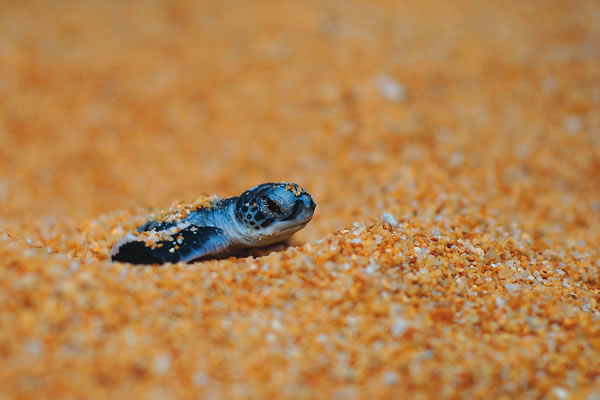 Situated northwest of Puerto Rico’s only navigable river, the Espiritu Santo River, and near the El Yunque National Forest, the Bahia Beach Resort & Golf Club is part of an intricate ecosystem. Audubon International was keenly interested in the project, impressed with not just the beauty of the land, but also the impact on the substantial ecosystems nearby.
Situated northwest of Puerto Rico’s only navigable river, the Espiritu Santo River, and near the El Yunque National Forest, the Bahia Beach Resort & Golf Club is part of an intricate ecosystem. Audubon International was keenly interested in the project, impressed with not just the beauty of the land, but also the impact on the substantial ecosystems nearby.
“Working with the developer to protect this whole landscape was a tremendous undertaking, but with the goal to protect the ‘last wild’ of Puerto Rico,” says Nancy Richardson, Audubon International program director.
Audubon was involved in the entire process, from the design to the drainage, to help ensure that the animal habitat and water resources were protected. Most developments are concerned with only the bottom line, Richardson says, but Bahia Beach Resort took the Audubon requirements to heart. Today, more than 65 percent of the property is preserved as green areas, sanctuaries and nature trails.
According to Richardson, the owners of the resort are committed to protecting the environment because it is the right thing to do. “That is the difference between Bahia Beach and other traditionally built developments,” she explains. “There is support from the top to integrate a philosophy of sustainability not only throughout the resort and its staff, but also beyond, into the local communities.”
Instead of cutting trees to clear the land for construction, more than 5,000 trees were transplanted. An onsite nursery was established to grow native vegetation and since 2006, more than 76,000 plants and 12,000 trees have been reintroduced to the area. The nursery is primarily a hydroponic garden and also grows vegetables and herbs; guests and residents of The St. Regis Bahia Beach Resort can tour and purchase produce here.
Majestic Manatees
Turtles aren’t the only species that call Bahia Beach Resort & Golf Club home. Antillean manatees, the large marine mammals with wrinkled, whiskery faces and rotund bodies, love to swim in the waters in front of the hotel, Cañón says.
Looking straight out to the ocean, observers can occasionally see a large grey colored nose pop out of the water, accompanied by bursts of air and water—similar to the sound a whale makes when exhaling through its blowhole. Where there is one, there is likely more, particularly calves that like to stay near their mother for three to four years after birth.
Like the leatherback turtles, manatees are also endangered. Fewer than 300 manatees in the wild are remaining in Puerto Rico, says Dr. Antonio A. Mignucci-Giannoni, lead oceanographer of Puerto Rico’s Manatee Conservation Center.
But Bahia Beach Resort works with Puerto Rico’s Center of Manatee Conservation to protect them through donations and by keeping a watchful eye. Thanks to the resort’s staff reporting any distressed manatee sightings, the Manatee Conservation Center is able to rescue the animals in the Bahia Beach area.
Another place to spot manatees nearby the resort is in the Ensenada Comezón, just south of the property. “Because boats are the manatees’ biggest threats, and there aren’t many in Ensenada Comezón, it’s a great place to see manatees in the wild,” Mignucci-Giannoni says.
Many natural treasures and the animals inhabiting it are being destroyed around the world for economic gain, but Bahia Beach Resort & Golf Club is one destination where comfort and consciousness are not mutually exclusive.
“Watching the changes in the color of the water as the waves break on shore is mesmerizing. Although not native, the naturalized tall palm trees waving in the breeze surrounded by lush, dense, verdant vegetation promises all sorts of secrets to be uncovered behind each palm frond or under each bush,” Richardson says. “This really is a resort that everyone should visit. But beyond the first-class comfort and service, one finds those proud of their heritage and committed to maintaining the island’s natural history.”

